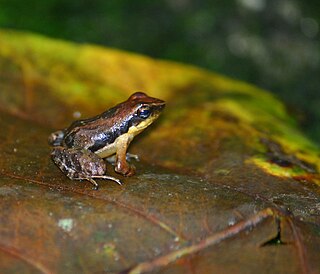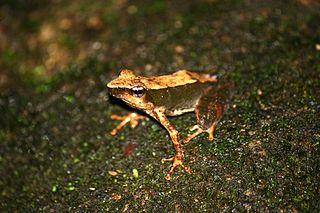
A tadpole is the larval stage in the biological life cycle of an amphibian. Most tadpoles are fully aquatic, though some species of amphibians have tadpoles that are terrestrial. Tadpoles have some fish-like features that may not be found in adult amphibians such as a lateral line, gills and swimming tails. As they undergo metamorphosis, they start to develop functional lungs for breathing air, and the diet of tadpoles changes drastically.

The conservation status of a group of organisms indicates whether the group still exists and how likely the group is to become extinct in the near future. Many factors are taken into account when assessing conservation status: not simply the number of individuals remaining, but the overall increase or decrease in the population over time, breeding success rates, and known threats. Various systems of conservation status are in use at international, multi-country, national and local levels, as well as for consumer use such as sustainable seafood advisory lists and certification. The two international systems are by the International Union for Conservation of Nature (IUCN) and The Convention on International Trade in Endangered Species of Wild Fauna and Flora (CITES).

Micrixalus is a genus of frogs from that are endemic to the Western Ghats in India. They are monotypic within the family Micrixalidae. Before being raised to the family level they were classified as the subfamily Micrixalinae within Ranidae. Micrixalus frogs, such as Micrixalus saxicola, are popularly known as "dancing frogs" due to their peculiar habit of waving their feet to attract females during the breeding season. Dancing frogs are extremely vulnerable as their habitat is severely threatened.

Staurois is a small genus of minuscule true frogs. Most species in the genus are restricted to Borneo, but two species are from the Philippines. This genus is a quite ancient member of the true frog family, Ranidae. They are typically found in or near rapidly flowing, small rocky streams, and are sometimes known as splash frogs or foot-flagging frogs. The latter name refers to their unusual behavior of conspicuously waving their hindlegs and feet, as a way of signalling other members of the species. Similar behavior has also been documented in other frog genera, notably Hylodes and Micrixalus.

Micrixalus fuscus is a species of small frog found in dense forested hill streams in the Western Ghats of India. M. herrei was formerly synonymized within this species.

Micrixalus saxicola is a species of frog in the family Micrixalidae, found in forest streams in the Western Ghats of India.This frog has a brown colored dorsum and a white ventral side with irregular white specks on its dark brown throat and chest. Its smooth skin and cryptic coloration allow it to blend into its surroundings while resting or calling. The males of the species are territorial, and will use calling, foot tapping, and foot flagging to warn off competition. M. saxicolais is described by the IUCN as a vulnerable species due to habitat loss, fragmentation, and human interference.The frog also threatened by infection by the fungus Batrachochytrium dendrobatidis.
Limnonectes micrixalus is a species of frog in the family Dicroglossidae. It is endemic to the Philippines.

Micrixalus elegans is a species of frog in the family Micrixalidae. It is endemic to the Western Ghats, India, and occurs between the Palakkad Gap and Goa Gap in the states of Kerala and Karnataka. Micrixalus elegans is one of the Micrixalus species showing "foot-flagging" behaviour, hence the common name elegant dancing frog has been proposed. Other common names include elegant torrent frog and elegant bush frog.

Micrixalus gadgili is a species of frog in the family Micrixalidae. It is endemic to the southern Western Ghats, India.

Micrixalus kottigeharensis is a species of frog in the family Micrixalidae. It is endemic to the Western Ghats in Karnataka, India. It is one of the "Top 100 Evolutionarily Distinct and Globally Endangered (EDGE) Amphibians". The specific name means "from Kottigehara".

Micrixalus nudis is a species of frog in the family Micrixalidae. It is endemic to the Western Ghats, India.

Micrixalus phyllophilus is a species of frog in the family Micrixalidae. It is endemic to the Western Ghats, India.

Micrixalus silvaticus is a species of frog in the family Micrixalidae. It is endemic to the Western Ghats, India.

The World's 25 Most Endangered Primates is a list of highly endangered primate species selected and published by the International Union for Conservation of Nature (IUCN) Species Survival Commission (SSC) Primate Specialist Group (PSG), the International Primatological Society (IPS), Global Wildlife Conservation (GWC), and Bristol Zoological Society (BZS). The IUCN/SSC PSG worked with Conservation International (CI) to start the list in 2000, but in 2002, during the 19th Congress of the International Primatological Society, primatologists reviewed and debated the list, resulting in the 2002–2004 revision and the endorsement of the IPS. The publication was a joint project between the three conservation organizations until the 2012–2014 list when BZS was added as a publisher. The 2018–2020 list was the first time Conservation International was not among the publishers, replaced instead by GWC. The list has been revised every two years following the biannual Congress of the IPS. Starting with the 2004–2006 report, the title changed to "Primates in Peril: The World's 25 Most Endangered Primates". That same year, the list began to provide information about each species, including their conservation status and the threats they face in the wild. The species text is written in collaboration with experts from the field, with 60 people contributing to the 2006–2008 report and 85 people contributing to the 2008–2010 report. The 2004–2006 and 2006–2008 reports were published in the IUCN/SSC PSG journal Primate Conservation,, since then they have been published as independent publications.

Micrixalus adonis is a newly described species of frogs in the family Micrixalidae. It is endemic to the Western Ghats in southern India, restricted to areas between the Palghat Gap and Shencottah Gap. Common name beautiful dancing frog has been proposed for this species, in reference to its vividly rich colouration.

Micrixalus herrei is a newly redescribed species of frog in the family Micrixalidae. Originally described in 1942, it was synonymized with M. fuscus in 1984. However, morphological differences as well as DNA evidence confirm this species to be valid. It is endemic to the Western Ghats, India, and occurs south of the Shencottah Gap in Kerala and Tamil Nadu states. The common name Kallar dancing frog has been proposed for this species, in reference to Kallar, Trivandrum, its type locality.
Micrixalus kodayari, also known as the Kodayar dancing frog, is a species of frogs in the family Micrixalidae. It is endemic to the Western Ghats south of the Shencottah Gap in Tamil Nadu, India; it is known from Kodayar and Kakkachi.
















